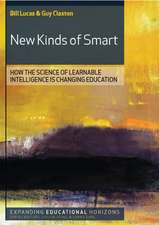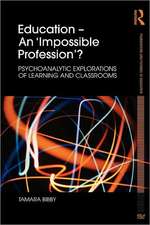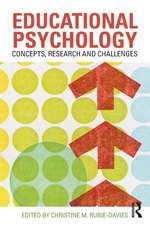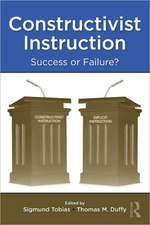The Routledge International Handbook of Research on Teaching Thinking: Routledge International Handbooks of Education
Editat de Rupert Wegerif, Li Li, James C. Kaufmanen Limba Engleză Hardback – 3 iun 2015
Containing surveys and summaries of international, cutting-edge research on every aspect of teaching thinking in a range of contexts, the handbook is thorough in its delivery, examining many different approaches and methods to help readers understand what teaching thinking is and how we can best take this movement forward. Key topics include:
• Theoretical perspectives on teaching thinking
• Approaches for teaching thinking
• Developing creative thinking
• Developing critical thinking and metacognition
• The assessment of thinking
• Teaching thinking in the context of STEM
• Collaborative thinking and new technology
• Neuro-educational research on teaching thinking
This book is an essential guide for policy-makers, teachers and researchers who are interested in teaching thinking
| Toate formatele și edițiile | Preț | Express |
|---|---|---|
| Paperback (1) | 339.94 lei 43-57 zile | |
| Taylor & Francis – 12 oct 2017 | 339.94 lei 43-57 zile | |
| Hardback (1) | 1303.70 lei 43-57 zile | |
| Taylor & Francis – 3 iun 2015 | 1303.70 lei 43-57 zile |
Din seria Routledge International Handbooks of Education
-
 Preț: 385.11 lei
Preț: 385.11 lei -
 Preț: 340.71 lei
Preț: 340.71 lei - 9%
 Preț: 1490.98 lei
Preț: 1490.98 lei -
 Preț: 341.06 lei
Preț: 341.06 lei -
 Preț: 334.02 lei
Preț: 334.02 lei - 9%
 Preț: 1594.01 lei
Preț: 1594.01 lei -
 Preț: 367.55 lei
Preț: 367.55 lei -
 Preț: 471.80 lei
Preț: 471.80 lei - 12%
 Preț: 331.87 lei
Preț: 331.87 lei - 12%
 Preț: 331.87 lei
Preț: 331.87 lei -
 Preț: 422.58 lei
Preț: 422.58 lei - 29%
 Preț: 1185.83 lei
Preț: 1185.83 lei -
 Preț: 416.22 lei
Preț: 416.22 lei -
 Preț: 466.02 lei
Preț: 466.02 lei -
 Preț: 455.78 lei
Preț: 455.78 lei - 18%
 Preț: 1574.36 lei
Preț: 1574.36 lei - 22%
 Preț: 455.27 lei
Preț: 455.27 lei - 11%
 Preț: 302.55 lei
Preț: 302.55 lei - 12%
 Preț: 331.87 lei
Preț: 331.87 lei - 12%
 Preț: 331.87 lei
Preț: 331.87 lei - 25%
 Preț: 541.50 lei
Preț: 541.50 lei - 26%
 Preț: 1830.09 lei
Preț: 1830.09 lei - 25%
 Preț: 1194.82 lei
Preț: 1194.82 lei - 18%
 Preț: 1568.21 lei
Preț: 1568.21 lei - 11%
 Preț: 341.86 lei
Preț: 341.86 lei - 18%
 Preț: 1554.29 lei
Preț: 1554.29 lei - 24%
 Preț: 426.49 lei
Preț: 426.49 lei - 15%
 Preț: 572.34 lei
Preț: 572.34 lei - 18%
 Preț: 1557.14 lei
Preț: 1557.14 lei - 18%
 Preț: 1617.55 lei
Preț: 1617.55 lei -
 Preț: 455.78 lei
Preț: 455.78 lei - 18%
 Preț: 1571.83 lei
Preț: 1571.83 lei - 15%
 Preț: 567.41 lei
Preț: 567.41 lei - 11%
 Preț: 343.25 lei
Preț: 343.25 lei - 31%
 Preț: 1689.67 lei
Preț: 1689.67 lei - 11%
 Preț: 339.94 lei
Preț: 339.94 lei
Preț: 1303.70 lei
Preț vechi: 1749.56 lei
-25% Nou
Puncte Express: 1956
Preț estimativ în valută:
249.46€ • 261.16$ • 206.41£
249.46€ • 261.16$ • 206.41£
Carte tipărită la comandă
Livrare economică 07-21 aprilie
Preluare comenzi: 021 569.72.76
Specificații
ISBN-13: 9780415747493
ISBN-10: 041574749X
Pagini: 512
Ilustrații: 3 black & white illustrations, 16 black & white tables, 3 black & white halftones, 21 black & white line drawings
Dimensiuni: 174 x 246 x 33 mm
Greutate: 1.04 kg
Ediția:1
Editura: Taylor & Francis
Colecția Routledge
Seria Routledge International Handbooks of Education
Locul publicării:Oxford, United Kingdom
ISBN-10: 041574749X
Pagini: 512
Ilustrații: 3 black & white illustrations, 16 black & white tables, 3 black & white halftones, 21 black & white line drawings
Dimensiuni: 174 x 246 x 33 mm
Greutate: 1.04 kg
Ediția:1
Editura: Taylor & Francis
Colecția Routledge
Seria Routledge International Handbooks of Education
Locul publicării:Oxford, United Kingdom
Public țintă
PostgraduateCuprins
Introduction. Rupert Wegerif, Li Li, James C. Kaufman.
Section 1: Theory, history and context of teaching thinking
Section 1: Theory, history and context of teaching thinking
- Teaching for Thinking: Ethical Reasoning. Robert J. Sternberg
- A Recent History of Teaching Thinking. Steve Higgins
- Teaching Thinking: An Ideological Perspective. Yoram Harpaz
- A Confucian perspective on teaching thinking in China. Li Li.
- There’s more to thinking than the intellect. Douglas P. Newton.Section 2: Approaches to teaching thinking
- Tools for Inquiry: the role of thinking skills approaches in developing pedagogy as theory. Vivienne Baumfield.
- How to improve thinking. P.N. Johnson-Laird
- Thinking-Based Classroom Teaching Theory and Practice in China. Weiping Wei.
- Philosophy for Children: Short and long term effects. K., J., Topping and S. Trickey.
- Teaching for Successful Intellectual Styles. Li-fang Zhang.
- The Prospects of Cognitive (Brain) Training as an Aid for Teaching Thinking. Oshin Vartanian and Erin L. Beatty.
- Using an Informed Understanding of Styles to Enhance Learning and Teaching in 21st century Learning Environments. Carol Evans and Michael Waring.Section 3: Creativity and creative thinking
- Possibility Thinking: from what is to what might be. Anna Craft
- Promoting Creativity in Chinese Classrooms: An Examination Based on Educational Policies. Zhaocun Li, and Amber Lauren Johnston.
- What we want impacts how we create: Creativity, motivation, and goals. James C. Kaufman, Roni Reiter-Palmon and Ryan Royston.
- Integrating Knowledge Management into the Instruction of Creativity in a Blended Learning Environment. Yu-chu Yeh.
- Teaching Creative Thinking in K12 Schools: Lingering Challenges & New Opportunities. Ronald A. Beghetto.
- Thinking Creatively Across the Lifespan. Anna Hui.Section 4: Critical thinking and metacognition
- Metacognition and teaching higher order thinking (HOT) in science education: Students' learning, teachers' knowledge and instructional practices. Anat Zohar and Sarit Barzilai.
- Knowledge, disciplinarity and the teaching of critical thinking. Tim Moore.
- Metacognitive Learning Environments: An approach to metacognition research. Shirley Larkin.
- An Overview of Metacognitive Awareness and L2 Reading Strategies. Pingyu Liu and Li Li.
- Thinking about metacognition improves thinking. Marcel V.J. Veenman.Section 5: The assessment of thinking
- Do They Really Work? Evidence For The Efficacy Of Thinking Skills Approaches In Affecting Learning Outcomes: The Need For A Broader Perspective. Robert Burden.
- Assessing Critical Thinking in Our Students. Heather A. Butler.
- Assessing Creative Thinking: Practical Applications. Haiying Long and Jonathan A. Plucker.
- Assessment for creative teaching and learning in disciplined improvisation. Vivian M. Y. Cheng.
- A Model for the Assessment of Rational Thought and its Potential Operationalization. Richard F. West Keith E. StanovichSection 6: Teaching thinking in STEM subjects
- STEM Education and Problem-Based Learning Areej M. Adel El Sayary, Sufian A. Forawi, and Nasser Mansour
- The Teaching and Learning of Probabilistic Thinking: Heuristic, Informal and Fallacious Reasoning. Egan J Chernoff and Bharath Sriraman.
- Cognitive Acceleration through Science Education: The CASE for thinking through Science. Mary Oliver and Grady Venville.
- Epistemic practices and thinking in science: fostering teachers' development in scientific argumentation. Sibel Erduran and Merce Garcia-Mila.
- Teaching Engineers to Think Creatively: Barriers and Challenges in STEM Disciplines. David H Cropley.
- Teaching Mathematics Creatively. Ai-Girl TanSection 7: Teaching thinking through collaboration and new technology
- Technology and teaching thinking: why a dialogic approach is needed for the 21st Century. Rupert Wegerif.
- Catalyzing Collaborative Learning and Collective Action for Positive Social Change through Systems Science Education. Michael Hogan, Owen Harney and Benjamin Broome
- Becoming a questioner in a philosophy class. Baruch B. Schwarz and Ben Zion Slakmon
- Thinking, Interthinking, and Technological Tools. Simon Knight and Karen Littleton.
Notă biografică
Rupert Wegerif is a Professor of Education at the University of Exeter, UK.
Li Li is a Senior Lecturer at the University of Exeter. UK.
James C. Kaufman is a Professor of Educational Psychology at the Neag School of Education, University of Connecticut, USA.
Li Li is a Senior Lecturer at the University of Exeter. UK.
James C. Kaufman is a Professor of Educational Psychology at the Neag School of Education, University of Connecticut, USA.
Recenzii
The handbook chapters cover teaching thinking based upon critical thinking, stimulating interest and motivation, cognitive conflict, social construction, self-regulation and metacognition, application and transfer, creating good teaching contexts, teaching according to different aptitudes, and developing students’ creative capacity.
Calvin S. Kalman, Science & Education: Contributions from the History, Philosophy and Sociology of Science and Mathematics.
Calvin S. Kalman, Science & Education: Contributions from the History, Philosophy and Sociology of Science and Mathematics.
Descriere
The Routledge International Handbook of Research on Teaching Thinking provides a comprehensive guide to the current state of the art in research on teaching thinking. Across the world education for thinking is seen as the key to thriving in the Internet Age. The OECD suggest teaching thinking as key to growing a more successful economy, others claim it is needed for increased democratic engagement and for the well-being of individuals faced with the complexity of a globalised world. However there are questions about what we mean by ‘thinking’, how best to teach it and how best to access it. This book contains surveys and summaries of cutting edge research on every aspect of research on teaching thinking in a range of contexts. It is an essential guide for policy-makers, teachers and researchers who are interested in teaching thinking.












